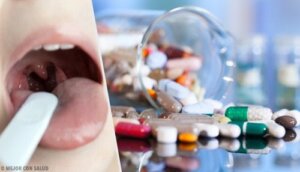Treatment for Acute Tonsillitis


Written and verified by the doctor Maricela Jiménez López
To treat acute tonsillitis, the most popular solution is usually to use penicillin. In most cases, this medication eradicates the bacteria completely, without the need for any other drugs. However, there may be exceptions that require other measures.
What is acute tonsillitis?
Tonsillitis is an acute febrile process with inflammation of the pharyngotonsillar area. The condition forms in the palatine tonsils and other lymphoid formations of the oropharynx. Among the most significant bacteria causing acute tonsillitis is beta-hemolytic streptococcus group A (EbhGA).
In colloquial terms, this disease is known as angina. It directly affects the oral bacterial flora and indirectly affects other areas of the body. Anyone is susceptible to it; however, it’s very common in children over 3 years of age and older adults.
This condition shows itself suddenly after an incubation period of 2 to 4 days. The pain may reach the ear area and cause discomfort in the back of the neck. Because of this discomfort, moving the neck becomes a problem.
Another recommended article for you: How to Naturally Soothe Swollen Tonsils
What are the symptoms?

Generally, a case of acute tonsillitis is accompanied by these symptoms:
- Fever
- A lack of appetite
- General malaise
- A sore throat
- A runny nose
- Swollen tonsils
- Lethargy – caused by the temporary and complete loss of sensitivity and movement due to a physiological cause not yet identified.
How is acute tonsillitis diagnosed?
In order to determine whether EBhGA bacteria are in the body, a culture of fauces exudate is required. This is performed based on the patient’s age and symptoms; family epidemiology is also important to confirm infection.
The test, which is 99% effective, can identify the cell wall carbohydrate of EbhGA from the tonsil and posterior pharyngeal wall. A serological test can also be performed to determine the presence of antibodies and of that pathogenic agent in particular.
According to Dr. María Estela García Díaz, from the Mexican Health Secretariat, it’s best to distinguish between true pharyngeal infection and the pharyngeal redness that occurs in colds that affect the upper respiratory tract. This is because the treatment is different.
She adds that the causes that can condition acute pharyngitis are the abrupt changes in temperature at the end of autumn and the beginning of winter.
Is there any medical treatment for acute tonsillitis?
Antibiotics
The antibiotic treatment for tonsillitis consists of the use of penicillin and amoxicillin. In some cases, penicillin G benzathine is administered by deep intramuscular route in a single dose. Besides being painful, this alternative isn’t recommended unless vomiting is present or oral treatment doesn’t work.
Also, according to Dr. Hijano Bandera’s rationale, oral cephalosporins and macrolides shouldn’t be used as first-choice antibiotics, except for cefadroxil, in case of a history of delayed allergy to beta-lactams.
You may be interested in: The Side Effects of Antibiotics
Mouthwashes
Mouthwashes are aqueous solutions that act on the mucous membranes of the oral and throat area. The healing process consists of rinsing the mouth; the mouth must be kept open without swallowing any saliva.
Their most common compounds are water, ethanol, humectants, and flavorings. They usually have the following properties:
- Antiseptics: Certain mouthwashes have the function of preventing infections, since they eliminate the bacteria present in the tissues.
- Local anesthetics: These reduce pain and sensitivity in the tongue and throat. Some examples are lidocaine, benzocaine, and tetracaine.
- Decongestants and expectorants: The most frequent are camphor, chlorophyll, gomenol, menthol, terpineol, pine essence, and eucalyptus.
Symptomatic treatment

Ultimately, to treat acute tonsillitis, measures can be taken that aim to palliate the symptoms:
- Self-medication isn’t recommended.
- Ventilate the entire home daily for at least 20 minutes.
- Take hygienic measures: Use disposable handkerchiefs, cover your mouth and nose when coughing or sneezing, and wash your hands after coughing on them to avoid contagion and also if you have to handle food.
- Eat only soft foods and increase fluid intake: Avoid citrus juices because they’re very acidic and irritate the inflamed mucosa. Also, eliminate alcohol and tobacco from the diet, and don’t eat spicy foods.
What’s the prognosis of acute tonsillitis?
In most cases, symptoms of tonsillitis improve within two to three days after treatment is started. It rarely causes complications.
The prognosis is quite encouraging, as it’s almost always possible to cure the infection if you complete the course of treatment. However, some patients need more than one course to achieve complete improvement.
Finally, it’s worth mentioning that if the pain persists, you should seek medical assistance. In such cases, analgesic, antipyretic and anti-inflammatory drugs, such as acetylsalicylic acid, may be required.
All cited sources were thoroughly reviewed by our team to ensure their quality, reliability, currency, and validity. The bibliography of this article was considered reliable and of academic or scientific accuracy.
- El-Hakim, H. (2017). Tonsillectomy or adenotonsillectomy versus non-surgical treatment for chronic/recurrent acute tonsillitis. Paediatrics and Child Health (Canada). https://doi.org/10.1093/pch/pxw004
- Kraft, K. (2011). Tonsillitis. MMW-Fortschritte Der Medizin. https://doi.org/10.1007/BF03368657
- Windfuhr, J. P., Toepfner, N., Steffen, G., Waldfahrer, F., & Berner, R. (2016). Clinical practice guideline: tonsillitis I. Diagnostics and nonsurgical management. European Archives of Oto-Rhino-Laryngology. https://doi.org/10.1007/s00405-015-3872-6
This text is provided for informational purposes only and does not replace consultation with a professional. If in doubt, consult your specialist.








